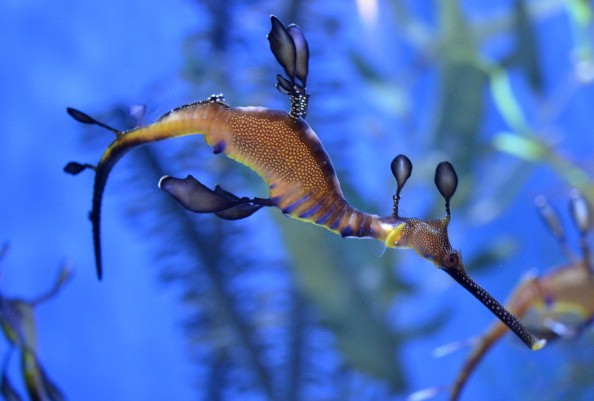The sea dragon is one of the most elaborately camouflaged animals on the earth. They are excellently equipped to blend in with the seaweed and kelp formations they live among, covered in gossamer, leaf-shaped appendages.

Yet, sea dragons are more complex than the average diver realizes. Sea dragons may be bedazzling but lack ribs and fangs and have bent and kinked spines.
Sea Dragon Genes
The genomes of sea dragons are rich with repeating DNA sequences that drive evolution, but they also lack a group of genes that give birth to teeth, nerves, and facial features in other animals. These genetic hints may help scientists understand why sea dragons seem remarkably unique.
In a recent report, the study's authors write that studying sea dragon genomes has "lifted a veil on the development of sea dragon-specific features" and "exposed exciting evolutionary facets of this rare vertebrate family, the Syngnathidae, as a whole."
Sea dragons are members of the Syngnathidae family, which includes pipefish and sea horses and are notable for having evolved male pregnancy.
According to evolutionary genomics researcher Clayton Small of the University of Oregon, who co-led the study with colleague Susan Bassham, "This group is just cool for various reasons."
Also Read : "Ugliest Thing Ever" - Mysterious Deep-Sea Creature Leaves Fisherman in Awe in Australia
An Odd Bunch
But sea dragons stand out among a group of fish that are already oddballs.
The leafy sea dragon and the weedy or common sea dragon, located in chilly seas off the southernmost beaches of Australia, were the two sea dragon species whose genomes were sequenced by Small, Bassham, and the team to find out why.
This skinny fish can be challenging to see as they drift across kelp-covered rocky reefs while concealing themselves with leaf-like fronds.
They are so secretive that the rare ruby sea dragon, one of just three kinds of sea dragons, was only recently spotted in the wild for the first time in 2017.
The three sea dragons are admired for their vivid, fantasy body shapes and long, tubular snouts used for sucking up crustaceans. Nevertheless, the ruby sea dragon lacks the other species' leafy appendages, suggesting that evolution has stripped away the showy frills.
Scientists believe sea dragons rapidly evolved their ostentatious traits when they and sea horses split off to establish a different family about 50 million years ago.
How they got to look so unique, though, is still being determined. To evaluate the samples obtained from sea dragons bred in captivity, the researchers from the University of Oregon collaborated with specialists from the Tennessee Aquarium and the Birch Aquarium at Scripps Institute of Oceanography.
Sea dragons contain very high transposons, sometimes called "jumping genes," in their genetic code compared to their nearest cousins, pipefish, and seahorses.
Transposons can quickly alter the genetic makeup of an organism by hopping throughout the genome, which explains why sea dragons evolved so quickly.
The genomes of leafy and weedy sea dragons lack a significant portion of genes that play essential roles in other vertebrates, including instructions on how to form facial structures, teeth, limbs, and even parts of the central nervous system. This is in contrast to two distant relatives, zebrafish and sticklebacks.
Needing More Research
Further research will be required to fully understand the evolutionary history of sea dragons and their cousins, despite the researchers' inclination to hypothesize that the loss of these genes may have contributed to the development of their elongated facial features and extravagant frills.
The ornamental appendages most likely originated from spines, according to high-resolution X-ray microscope scans of a foot-long adult male weedy sea dragon specimen that the researchers also conducted.
According to Bassham, we could see that the leafy paddles' supports resembled elaborate spines with fleshy appendages appended to the ends.
The team also observed that these bony supports were not like the ossified, hardened bones found in the fins of most bony fish but rather appeared to be strengthened by a core of collagenous tissue, contributing to the explanation for how the sea dragon's distinctive body architecture came to be.
The end product, however, sea dragons originated, is magnificent, even gorgeous. Sea dragons may still have some hidden genetic mysteries that can be discovered through additional genetic comparisons.
Read also: Plenty of Fish in the Sea: "Ugly" Fishes Found to be at Risk More Compared to the "Beautiful" Ones
For the most recent updates from the animal kingdom, don't forget to follow Nature World News!
© 2025 NatureWorldNews.com All rights reserved. Do not reproduce without permission.





